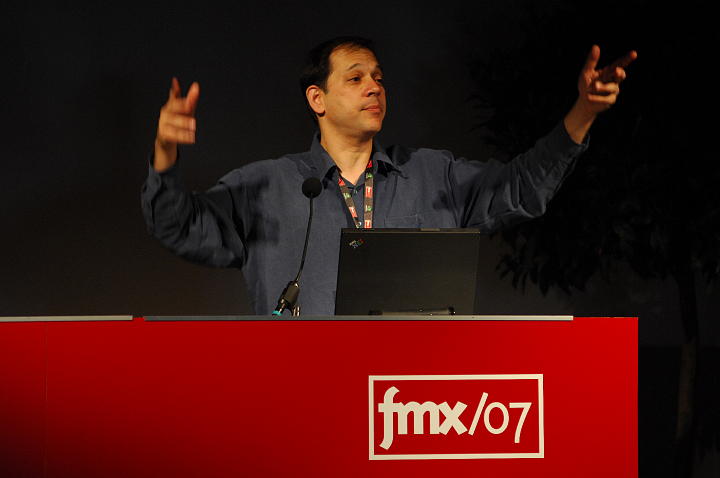fmx/07 coverage, day one: of Web 2.0 and virtual worlds
Day one was pretty "slow". Well, "slow" is not the right word here. Let's say that it was less focused on games than the other days. Of course, that doesn't mean that it was not interesting and that games were totally absent from the discussion. In fact, they were there - but instead of having technical discussions about some weird features, the selected speakers gave us their thoughts about what make them appealing, what are their strengths, their weaknesses and - finally - how they envision the future. That was the fmx/review day.
Web 2.0 - where the mass meets
By Inga von Staden, Investor, Medienboard Berlin-Brandenburg GmbH

Although it was not really game-oriented, I attended this talk because I wanted to get a clearer view on what buzzwordy Web 2.0 is (and because this was an introductory talk to the WoW and SL talks that took place right after). To be honest, I'm not sure my view is clearer now, but I still learned some bits about this whole new world. In favor of Ms. von Staden, I shall say that the definition of Web 2.0 was not the purpose of her talk: she wanted to speak about communities, and she did that well.
Ms. von Staden began with a short introduction of the WWW history. Since nearly everyone knows about it, I'll cover that even faster than she did. The World Wide Web was built on the ArpaNet US military network by Tim Berners-Lee and Robert Cailliau as a collaborative hypermedia, filled with text, images and other content - in other words: knowledge (as a side note, Inga von Staden made an interesting parallel between the binary code (1, 0) which is used to encode any digital media and the DNA code (A, C, T, G, in no particular order) which is more or less used to encode life (her own words were far more precise; but I'm not a biologist, so forgive me). Which brings us to an evidence: the binary code is the DNA of knowledge - 1 and 0 being the proteins of human thoughts).The WWW gained momentum and by the end of the 90's was deemed the idiomatic new technology. By the time the dot com bubble collapsed, the 10 year-old media already reached hundreds of thousands of homes. Something quite good happened then: the disinterest for any commercial use of the web and the rapid convergence of the other medias allowed it to grow and to evolve at his own peaceful rate, far from commercialism (well, not that far, but far enough). And in late 2004 / early 2005 it became clear that a new web experience was in creation: user generated and controlled content, communities, dynamic web sites and so on. That's what Tim O'Reilly called the Web 2.0 in a memorable presentation.
Two of the most important aspects of Web 2.0 are community and user-generated content.
There are plenty of examples for both aspects. Ms. von Staden cited Cyworld, a Korean community of 13 million users, or Habbohotel - the most popular community among the 10-13 year-old European children. Both are a mix of real world (community, friends) and virtual world (virtual place to meet, virtual online life). User-generated content is probably best shown with YouTube channels, and it's epiphenomena LonelyGirl15 (who does not exist, as revealed by the New York Times (the NYT article, which is not available for free online, is cited here by the Time Magazine)). Both aspects are the very basis of what have been called by buzzwordy experts the "folksonomy" - the user-generated classification of web content using tags (that's a contraction of "folk" and "taxonomy").
The folksonomy is at the very heart of the community effect: some lambda user creates some content, this content is flagged and tagged by a few other users, allowing more users to find and retrieve it. If this was a mathematical phenomenon, building communities would be quite easy - of course, that's not the case. So where does this community effect come from?
The answer from Ms. von Staden is quite simple: she describes this as the result of the Higgs effect (from the name of the physicist Peter Higgs). User-generated content which is pushed on the web is known to have three states: "personal", "popular" and "massive". Going from "personal" to "popular" typically involves interaction between the poster and an existing community. The Higgs effect takes place when the content goes from the "popular" state into the "massive" state. To sum up that effect: nobody knows how it works (hence the name coined by Ms. von Staden). Does 1-to-1 dialog (interaction of the community leader with individual community members) help? Probably, but that's difficult to measure. Are "quypes" (influential people, very active in a community) keys to the massive recognition? Although it seems that these quypes are nexuses on which the community can be enhanced, that's still quite hard to say.
Ms von Staden raised a lot of interesting questions in her talk. Of course, she concluded by trying to map Web 2.0 to the future. Many people in the fmx/07 conference tried to describe their vision of the future of the web - the so called Web 3.0 or Web 3D (people really love buzzwords...). Communities and user generated content are supposed to be an important part of this future. Seeing the growth of virtual worlds (WoW, Second Life), they may also be a key component of this future.
Wb n00bs, u roxxor! Imba! Welcome to the new virtual state of World of WarcraftBy Teut Weidemann, Managing Director, CDV Software Entertainment AG
Yes, World of Warcraft (a.k.a. WoW) is a game. But the very fact that this successful MMO has an effect on the real life (a.k.a. RL) of its players means that it's not only a game but it's also more than just that. That's the argument developed by Teut Weidemann during this session.
Before he presented his point, Teut gave us some surprising demographic facts: the average age of players is 26 years old - only 25% of the players are teenagers; 22% of the players have children, but given the fact that they spend an average of 22 hours in the game, they probably won't see them growing up. More interesting: 15 to 40% of the players are female players. Well, to be more honest, experts are pretty sure that at least 15% of the players are female players, but it's quite hard to say since 40% of the characters are female characters.
Of course, like many online communities of this size (9 million subscribers; Teut assured us that you start WoW as a game, but it ends as a passion), WoW is a highly social environment. As such, it mimics RL. You can meet friends or face crooks, you buy and sell things, you grow up (well... you level up), and so on. Not only does it mimic RL, but it has also an effect on it:
- it has an influence on the language. At this point, Teut cited his younger son who is, like him, an avid WoW player. His son is now used to saying "afk" when he leaves a place. While this move has not been initiated by WoW, the fact that it's a widely popular game with a strong sense of community helped to spread idioms that first came to life in chat rooms - like saying "lol" instead of laughing.
- a huge time is spent online. If some players only play a few hours per week, it means that some people spend their whole life in this virtual world (we'll remember the death of a Chinese kid who played continuously for more than 50 hours). The net effect is that all sorts of relationships are built, players are forging relations with in-game mates, and finally meet in RL. Of course, there is a downside (3% of the players lost their girlfriend/boyfriend/wife/husband/job/whatever because they spent too much time on WoW), but it is counterbalanced by the fact that 3% of the players gained the exact opposite (a job, a wife/husband, etc).
- a whole economy has been created around WoW - and it's worth 1 billion dollars. This is probably the clearest connection between RL and the virtual world of WoW.
Speaking of relationship that you can build or enhance in the game, Teut showed us (in a short game demo) that he is using WoW as a way to keep in touch with his children. They play together every evening or so, in the same guild, together with Teut's girlfriend. This might seem as an extreme example of connection between RL and virtual life, although it seems that this kind of behavior is quite frequent.
Finally, similarly to Ms. von Staden, Teut Weidemann gave us his vision of the future of games.
- games will be online by default, and most games will be massive in some way
- some connections will begin to emerge between different virtual worlds and games
- the real world will be more and more connected to the virtual worlds
Although that's a bit too prospective for me, I must confess that I'd like to see point two happen.
Creating tools for convivialityBy Florian Schmidt
For Florian, Second Life (SL) is a lot like LEGO: there is no story, no rules, no good/evil, no barriers to your creativity. Moreover, what you achieve (social links or constructions) stays in the persistent world. Of course, with this limitless scheme, you'll find little design in SL - as Florian said during the talk, most things you'll find are crap. But this is still interesting from a designers point of view, as the net result is: people create things.
In the past, media reported virtual worlds as a strange place where people were a bit crazy. Today, not only is there is a wide acceptance of Virtual Worlds (VW), but there is also a hype around the very idea of these worlds. The audience is broader, but now it wants the quality to rise.
There are more than 6 millions subscribers to SL, but people get frustrated - there is nothing to do in SL, you're really up to yourself; you have to involve yourself in the community in order to get some fun in return. While SL was one of the first VW, there are now hundreds of them, all trying to learn from the shortcomings of the pioneers:
- HipiHi, a bare Chinese rip.
- Kaneva, a mix of myspace and SL
- Virtual Me, from EA and Endemol
- Home (YouTube video from the GDC), from Sony, which focuses on social interaction - there is not much user generated content (meaning there is no ugly content), but there are loads of games to play. It's quite secure, although virtual sex is probably going to be an issue here as well.
- even a LEGO-based MMO is under construction
Most of these new VW have something in common: no sex/gambling, but also no artists/coder, no university/science, no embassy/news agency, ... Security comes with a drawback: you have to follow a set of rules, thus, you limit freedom and creativity.
Going through the user-gen content route doesn't mean that designers have less work to do. Obviously, they still have to create a stage for social interaction. While they lose their grasp on the content itself, they have to face a lot of other challenges, ranging from a better UI (today's avatars are quite limited in expressing emotions, and emotion is probably one of the key feature of VW) to new ways to share and mark content or allowing players to create their own story in the VW.
Florian thinks that to achieve that, the designers have to broaden their field of expertise - or, ideally, some people who are not typically involved in VW design should be. Experts from other fields have their opinions to say, as they can help in many key areas:
- politics - political issues are very difficult to manage. For example, how can one allow a player-lead government? Would this even be fun? If 51% of the government decides that the sun should be black, will the whole community accept it?
- economics
- social issues - and user behavior. How would you make users behave like they should behave?
- moral issues - how to deal with them? If your VW doesn't face moral issues, then there is a hard limitation in your VW.
- security - child protection (which links to moral issues), fraud, and so on. There are many security issues to handle, and that's kind of difficult too. Should content be moderated? What about censure or spying?
A party of experts is needed to handle all these problems: as per Florian, new kinds of teams should help to design new solutions to these issues.
Of course, there are other fields where the designers have to work: should a VW be a utopia or should it mirror our world? While VW are an opportunity to experiment, people tend to reproduce what they know. Moreover, the development price of a VW is quite high and as a consequence designers are less willing to use them to experiment (although second hand VW software might be cheaper, allowing for more experimentation). Is hyper realism a good art path? Painters and sculptors showed us that hyper realism is quite limited in use, not to mention that it might be boring in the long run.
Like his fellow speakers, Florian finished his talk by trying to figure the future of VW. He noted that while he is sure that at some time the meta-verse (connected VW) will arise, we are still very far from that, as nothing is standardized. The result might be an open meta-world, which could be browsed with a single 3D browser. And that would be damn cool.
Second Life Rocks / Second Life Sucks: Options, Vexations, VisionsBy Michael Rueger, Developer / Director of Studies

Michael presented us reasons why he thinks that SL rocks - and reasons why he thinks that SL is facing some serious issues. He began with a short study of the demographics (60% male, 40% female, average age of 33 years old), and a few insights into the SL playing mechanism (I mean, I think he spent about 20 minutes playing SL during the talk, explaining to us the different features of the game, showing us how wrong the major companies are who bought a place in SL without knowing what the players would do and how they would interact with their virtual stores) then went with a long list of good things in SL:
- the player is free to do whatever he wants,
- he never dies,
- by wandering in the world, you'll face the holy trinity: I mean, sex (that's amazing how people represent themselves), drugs (virtual drugs: magic weed that distorts your vision) and rock 'n roll (U2 "live" concert, and so on). But there is even more to see: e-learning, the fashion week, corporate presence, sports, spiritual life (churches) or entertainment - since everyone can do whatever s/he wants, nearly everything is possible.
- the item creation system of SL is quite good: people create what they want from "prims", they change the object behavior using scripts (the scripting system is quite simple), and they can sell the items to other people (for fake money, but this money can be converted into real dollars!)
Of course, nothing is perfect - even in a virtual world, and SL also has a list of shortcomings:
- the number of users that can be connected at a time makes the system lag, and the servers themselves are quite difficult to join - they are often off-line. This is supposed to be corrected by Lindsen in the near future.
- the number of "prims" that are allowed in a place is limited (and the limit is quite low). As a consequence, the number of players that can attend a particular event is also limited - which make those events a lot less attractive.
- the player is free to do whatever he wants.
Most of these issues are supposed to be corrected with the next releases of the client (which went Open Source earlier this year) and with server updates.
I don't remember the conclusion of Michael - to be honest, I tried to catch up with the previous speakers, and I didn't pay enough attention to his talk (sorry for that). Not to mention that it was already 6 o' clock, and I was a bit hungry... :)
Photos courtesy of the fmx/07 staff.
fmx/07 coverage, day two: bringing computers to life
While the first day of fmx/07 was a bit slow (ok, I mean less game-oriented than the other days), the second day was a bit too hot. I already said in my journal that I was unable to attend to Crytek's talks, but the day was still quite heavy, even without them. I managed to be a bit late for the first talk of the afternoon, so that leaves us with 3 very interesting slide fests. Here they are!
Illusion of Life Revisited
by Pr. Ken Perlin, New York University

Ken Perlin is known to make great talks - this one was not an exception. The famous father of the noise() function presented his latest work and thoughts on the procedurally-generated movement.
With a few exceptions, today's game characters have a hard time creating any kind of emotion. They show nothing, and as a consequence the players don't get emotionally involved in the game. So the question is: how can we get a good level of expressiveness in game characters? Or to reword it: how do we get from a standard game character to Shrek, and then to Captain Jack Sparrow?
Pr. Perlin gave us some hints, based on his research: we don't describe emotional states with full details. We don't describe the sad face of someone by saying "he had the mouth curved down, the outside part of the eye was falling" and so on. We just say: "based on his face, he look sad". The reason for that is that we have here multiple layers to take into account:
- First layer: the Physical Move. This is where you take care of the position of eyes, shoulders, feet, mouth, and so on. Ken Perlin created some educational tools to experiment with physical movement (for example, the Java applet Responsive Face (note: all the applets presented here have been used in real-time during Ken's talk). By itself, a physical move or position is not an expression of emotion.
- On that, you can superimpose the second layer: the Physical Direction - shoulder back, eyes squinted, and so on. Here, the movement itself is not described physically, but using a more general and abstract description. This is the exact equivalent of the stylesheets of your favorite word processing software - and in fact physical directions are stylesheets.
- The third layer is Emotional Direction layer - when you combine multiple physical directions (i.e. multiple stylesheets) to create a set of moves that correspond to an emotion (for example: acting sad might mean: shoulders bent, lids down, and so on).
- The fourth layer is built on top of the previous one: it's about figuring the response to an event or other actors (I kind of like Ken's formulation for that: "get annoyed when your date checks out that other girl").
In Ken Perlin's talk, style sheets are quite an important feature: it's about describing (precisely, using the possibilities given by the physical movement layer) individual moves. Such a work is better done using a professional of human behavior rather than animators - just like your word processing style sheets are created by style and typography specialists, not by the software programmers. The Polly applet shows how style sheets can be applied to a simple object. Combination of these styles would end up in something like the Emotive Virtual Actors applet, where you can control the style of each character individually, in order to express an emotion.
Ken's conclusion was a bit unusual - he presented a previous work, which he achieved with some other researcher (forgot her name, sorry), where their goal was to make a bunch of sheep procedurally dance a waltz. I'm pretty sure you'll hear of that later in the future (well, maybe not in your favorite game, as most games don't even feature any sheep).
Procedural Creation of Content - State of Art and Perspective
by Dr. S?bastien Deguy, CEO of Allegorithmics
Content in next-gen games is taking more and more resources. First of all, more and more storage is required to get these high level models or textures. For online games, the issue is even worse: even if today's bandwidth costs are quite stable, the bandwidth usage is rising faster and faster, leading to a tremendous cost increase. At the same time, the local bandwidth is still an issue - local buses are still quite small, even if computers are growing more and more powerful. To sum up things: we have more power, we have more memory than ever, but we are still limited by the intermediate layers. Not to mention that the production of high-quality content takes a lot of time, inducing another cost increase during the development phase of the product.
And these are of course not the only problems: as content is more and more realistic, it faces another issue as well: the uncanny valley, theorized by Masahiro Mori, which states that the small differences between what we see and what we expect to see (because we are used to seeing it) will induce a negative emotional response. To overcome this problem, we have to make things look more natural.
And, of course, these are two key areas where procedural content generation (PCG) might help a lot.
With PCG, the overall data size is small - because you don't store the result of the process, but the process itself. The quality of the content is also quite different, since noise functions make everything look more natural. PCG has many nice properties, but to be used effectively, a change in the production and rendering pipeline must occur.
Dr. Deguy pointed us to the fundamental changes which are required to go from the handcrafted content generation (HCG) to PCG.
- for HCG, you create the content and store the result on the disk. The result is read from the disk before it is displayed.
- PCG is different: you define/direct the content, and store its description on the disk. When you read it back, you have to generate the final content from the description before you'll be able to display it.
Defining the content is a non-linear operation - this is also another nice property of PCG vs. HCG. A small error in handcrafted content might lead to a complete rework of the content itself, and the same goes if you need another resolution or even a small variation. PCG, on the other hand, is made of processes that are linked together (it's a graph-based approach). It's quite easy to modify one node of the graph to create variation, or to define another resolution target. The addition of different kinds of noise helps the result to appear more natural.
A video is worth 1000 images. That's the reason why S?bastien presented us with the Bayou video, which presents a real-time 3D scene built using only procedural textures (created using Allegorithmic's MaPZone and imported in the demo using their ProFXengine). The demo features 320 high quality textures, for a total size on disk of... 318 KB.
To conclude, PCG also has another nifty feature that makes it quite impressive: since the creation of the final content is based on a process description, it's fairly easy to add time dependence in the process itself. The result is stunning: S?bastien presented us this 3D scene. No texture was changed between these two shots - but the texture appearance depends on a time factor.


When Pre-render meets Real Time
by S?bastien Racine, Associate Producer, Ubisoft Montreal
S?bastien started his talk by presenting us with the latest evolution of Ubisoft: in February, Ubisoft created an art studio. By doing that, they are trying to achieve multiple goals:
- broaden the game experience (by creating, for example, short movies that are linked to Ubisoft games: character's background and so on)
- reinforce the dialog between game developers and cinematic artists, and merge both experiences.
And this talk is the story of a successful merge between the game art team and the cinematic art team while working on the upcoming title Assassin's Creed. The reasoning behind this merge is actually quite simple:
- real-time looks more and more like cinematics
- there are still a few key differences - the main one being on the side of compositing (light management, atmospheric rendering, ...)
So the main goal is to optimize the production pipeline for next-gen games.
Ubisoft already worked on the issue of asset sharing between artistic teams. King Kong or Open Season were already sharing assets, but it's with the development of Assassin's Creed that the process was rebuilt to enhance it - all the characters and nearly all other models you'll see in the trailer of AC are also used in the game itself. One of the biggest advantage of asset transfer versus remodeling is that it allows more time to be spent on other things, ranging from new asset creation to better handling of cloth simulation (in the cinematic; of course, we don't speak of the physics engine here).
Of course, everything would be perfect if this operation was completely natural - you guessed it, it's not as easy as it seems. There are numerous problems that need to be overcome to make the whole process work: normal maps don't react to light in the same way (light settings for a cinematic can be quite different from the in-game light settings), textures may need some rework as seams might appear, and so on. New techniques need to be developed to decrease the impacts of these differences in the production pipeline.
S?bastien concluded his talk by trying to envision the future of this process. In his view, two elements need to be improved:
- games should adopt a cinematographic language: players should be able to control the camera, a film mode might be implemented in games, ...
- characters should display emotions - facial expressions, muscle movements, and so on.
These two elements, if improved, would reduce the gap between the asset needs for a game and for a cinematic even more.
Photos courtesy of the fmx/07 staff; ProFX screenshot courtesy of Allegorithmic.




